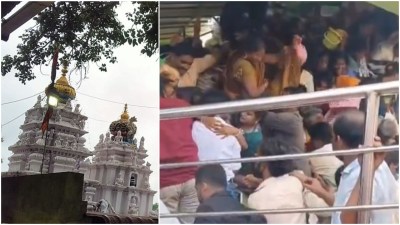Reforms: divided colours of saffron
LIKE all great Indian stories, this one, too, revolves around a family. During adverse times all the family members love one another, stick ...

LIKE all great Indian stories, this one, too, revolves around a family. During adverse times all the family members love one another, stick by each other, the elders sacrificing for the youngsters. But once prosperity sets in — and the youngest member lands a sarkari naukri — the inevitable fight breaks out among the siblings over the family silver.
However, unlike the great television family dramas, this one is not fictional, but factual. This is the great drama of India’s ruling family, the Sangh Parivar, the arbiter of the country’s future. The various scenes are enacted one after another, in Dilli’s corridors of power, in Mumbai’s numerous boardrooms, on the streets during massive rallies in Ayodhya and other towns, in political bickering in Jammu and Ahmedabad, and in the impenetrable citadel of Nagpur, the Sangh’s headquarters. Not only are the characters real, the conflict is based on material interests, with accusations and counter-accusations. There are rallies and protests, slogans and rhetoric, plots and machinations of real life more gory than reel life.
Let’s begin with the accusations levelled during the September 25 rally at the Capital’s Jantar Mantar by three Sangh Parivar outfits — the Swadeshi Jagran Manch, the Bharatiya Mazdoor Sangh and the Bharatiya Kisan Sangh — against the BJP-led NDA government’s ‘‘anti-people’’ economic reform policies. Although overshadowed by the Akshardham tragedy in Gujarat, and the VHP’s bandh call, the week-long countrywide agitation — it will end on October 2, coinciding with Mahatma Gandhi’s birthday — is being organised to ‘‘protect the nation from the onslaught of WTO’’.
The agenda of the three Sangh Parivar siblings is clear: ‘‘Pressure the NDA Government to stop its anti-people, anti-worker, anti-farmer and anti-small scale industry policies.’’ They demand priority of jobs over GDP growth; the non-acceptance of the WTO agreement as a fait accompli; the rejection of the N K Singh Committee report on FDI; a thorough review of economic policies and a review of the disinvestment policy.
The anger is palpable in the radical speeches of younger leaders like Arun Ojha and Girish Awasthi, who openly accuse the government of a ‘‘sell-out’’ to foreign interests, claims a senior RSS leader. Among the others who have addressed the cadres are SJM convenor Murli Dhar Rao, BMS president Hasmukh Dave, BKS president Kunwarjibhai Jadhav and other RSS swayamsevaks. More rallies have been planned at Nagpur, Jaipur, Bhopal, Lucknow, Patna, Kolkata, Ahmedabad and Mysore, to be addressed by senior RSS leaders such as Dattopant Thengadi and Mahesh Chandra Sharma.
‘‘No way,’’ claims a government spokesman. ‘‘The Swadeshi leaders simply do not have the mass following enjoyed by the sadhus and sants of the VHP, they are simply a band of misdirected, radical intellectuals who will eventually fall in line.’’
To this a senior RSS pra-charak counters: ‘‘The government is living under an illusion. Although it has the green signal from the BJP, no cabinet leader today has the support of even 15 of the 150 members of the BJP national executive. There is total factionalism at the top, all the ministers are spokespersons of vested interests.’’
Another Swadeshi leader claims, ‘‘The anger and alienation in the Sangh have touched new depths. If the Swadeshi movement does not force the government to pay attention to its agenda, the Sangh may even covertly support rival parties or whoever supports our agenda during the forthcoming assembly elections in various states.’’
|
Movement
|
versus
|
Government
|
||
|
||||
But does the Sangh really have that choice? Won’t it be forced to support the BJP in the next elections. Answers another Sangh leader: ‘‘Don’t forget how the RSS formed the Jammu State Morcha against the BJP when Advaniji refused to consider our demand of trifurcation of J&K. Also consider how the RSS has begun supporting the Shiv Sena over the BJP.’’
The sarkari naukar section of the family, however, continues to be optimistic. ‘‘There is no unity within the Swadeshi groups. Some are revolutionary socialists, others Gandhians, and still others evolutionaries,’’ says one cabinet minister. ‘‘They are simply feeling slighted because they have not been consulted on policy matters. Once they are, they will simply fall in line.’’
For all the chaos that seems to loom ahead, the Sangh Parivar crisis is not unique. German political observer Robert Michels pointed out in his Iron Law of Oligarchy that once governments form, they inevitably emasculate the movement that gave birth to it. It happened with the Labour Party and the labour movement in the UK, the Democratic Party and the populists in the US, Mao Tse Tung and the Communist Party in China and, closer home, with the Congress and the Sarvodaya movement.
When the crisis finally hits home, will the Sangh brothers unite and fight together? Or will the NDA government be forced to deradicalise the Swadeshi movement? ‘‘The Sangh leaders are our friends, they will not let the little heartburn engulf itself in such a crisis,’’ believes one optimistic minister. Many will be silently saying ‘Amen’ to that.



- 01
- 02
- 03
- 04
- 05




























